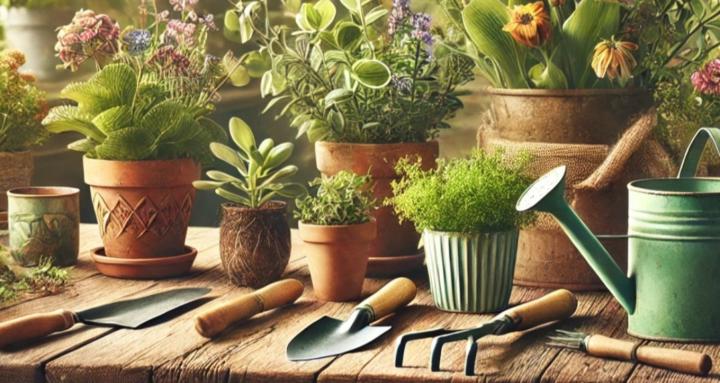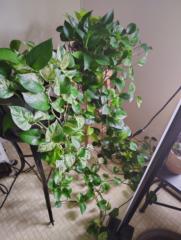17d • Pests & Plant Drama
Ants in Your Pots: Helpful Partners or Tiny Troublemakers?
If you’ve ever gone out to water your container garden and noticed a parade of ants marching across the soil, you might wonder: Are they helping—or are they here to wreak havoc?
The truth is, ants can play both roles in your garden, depending on the situation. Let’s break it down.
🌱 𝐓𝐡𝐞 𝐇𝐞𝐥𝐩𝐟𝐮𝐥 𝐒𝐢𝐝𝐞 𝐨𝐟 𝐀𝐧𝐭𝐬
Believe it or not, ants aren’t always the villains of the garden story.
* 𝐒𝐨𝐢𝐥 𝐀𝐞𝐫𝐚𝐭𝐨𝐫𝐬: As ants tunnel, they loosen the soil, improving airflow and drainage for your plant roots.
* 𝐍𝐚𝐭𝐮𝐫𝐚𝐥 𝐂𝐥𝐞𝐚𝐧-𝐔𝐩 𝐂𝐫𝐞𝐰: They carry away bits of decaying material, helping keep your containers tidy.
* 𝐏𝐞𝐬𝐭 𝐏𝐫𝐞𝐝𝐚𝐭𝐨𝐫𝐬: Certain ant species feed on small insects and larvae that could otherwise harm your plants.
In these cases, ants act as tiny, unpaid garden helpers!
🐜𝐖𝐡𝐞𝐧 𝐀𝐧𝐭𝐬 𝐁𝐞𝐜𝐨𝐦𝐞 𝐓𝐫𝐨𝐮𝐛𝐥𝐞𝐦𝐚𝐤𝐞𝐫𝐬
Unfortunately, ants aren’t always so friendly.
* 𝐅𝐚𝐫𝐦𝐢𝐧𝐠 𝐀𝐩𝐡𝐢𝐝𝐬: Ants are famous for “farming” aphids—protecting them in exchange for honeydew. If you see both ants and aphids, that’s a red flag.
* 𝐑𝐨𝐨𝐭 𝐃𝐢𝐬𝐫𝐮𝐩𝐭𝐢𝐨𝐧: Large colonies can disturb soil structure and root systems, especially in small pots.
* 𝐁𝐢𝐭𝐢𝐧𝐠 𝐈𝐧𝐯𝐚𝐝𝐞𝐫𝐬: Some species (like fire ants) can sting or bite, making your container garden a less pleasant place to work.
🌼 𝐖𝐡𝐚𝐭 𝐭𝐨 𝐃𝐨 𝐢𝐟 𝐀𝐧𝐭𝐬 𝐌𝐨𝐯𝐞 𝐈𝐧
* 𝐂𝐡𝐞𝐜𝐤 𝐟𝐨𝐫 𝐀𝐩𝐡𝐢𝐝𝐬: Look at the undersides of leaves. If aphids are present, address that issue first— ants are likely just tagging along.
* 𝐃𝐢𝐚𝐭𝐨𝐦𝐚𝐜𝐞𝐨𝐮𝐬 𝐄𝐚𝐫𝐭𝐡: A sprinkle of food-grade DE around the soil surface can deter ants without harming your plants.
* 𝐁𝐚𝐫𝐫𝐢𝐞𝐫 𝐓𝐫𝐢𝐜𝐤𝐬: Place your pots on saucers with a thin ring of water, or apply sticky barriers to pot rims to prevent ants from climbing up.
* 𝐀𝐯𝐨𝐢𝐝 𝐇𝐚𝐫𝐬𝐡 𝐂𝐡𝐞𝐦𝐢𝐜𝐚𝐥𝐬: Chemical sprays can harm your plants and soil life—opt for safer solutions.
🌿 𝐓𝐡𝐞 𝐁𝐨𝐭𝐭𝐨𝐦 𝐋𝐢𝐧𝐞
Ants in your pots aren’t always bad news. Sometimes they’re helpful little partners, and other times they’re bringing pests to the party. The key is observation: watch what’s going on in your containers, and you’ll quickly know whether your ants are friends or foes.
4
1 comment

skool.com/gardening
🌱 Unlock your green thumb in the most supportive container gardening group online — exclusive tips, plant hacks, and growing wins await!
Powered by





